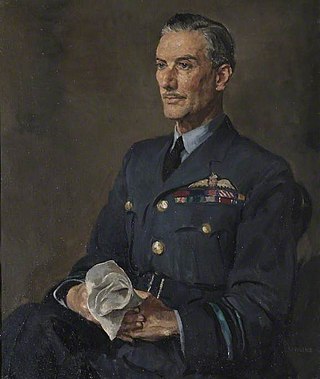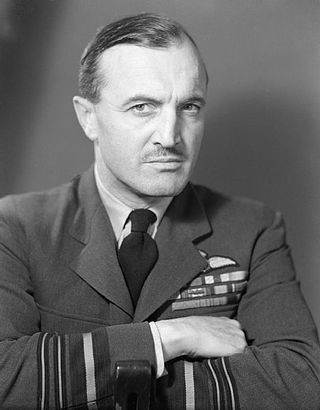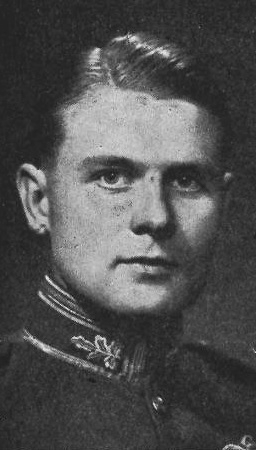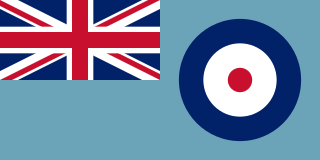Related Research Articles

Marshal of the Royal Air Force Arthur William Tedder, 1st Baron Tedder, was a Scottish senior Royal Air Force commander. He was a pilot and squadron commander in the Royal Flying Corps in the First World War and he went on to serve as a senior officer in the Royal Air Force during the inter-war years when he served in Turkey, Great Britain and the Far East.

Air chief marshal Sir Norman Howard Bottomley, was the successor to Arthur 'Bomber' Harris as Commander-in-Chief of RAF Bomber Command in 1945.

Marshal of the Royal Air Force Sir Edward Leonard Ellington, was a senior officer in the Royal Air Force. He served in the First World War as a staff officer and then as director-general of military aeronautics and subsequently as controller-general of equipment. In the inter-war years he held command positions in the Middle East, in India and then in Iraq. He served as Chief of the Air Staff in the mid-1930s and in that role he implemented a plan, known as 'Scheme F'. This scheme implemented an increase in the size of the Royal Air Force to 187 squadrons within three years to counter the threat from Hitler's Germany. He also broke up the command known as "Air Defence of Great Britain" to create RAF Fighter Command, RAF Bomber Command, RAF Coastal Command and RAF Training Command. He then served as Inspector-General of the RAF until his retirement in 1940.

Marshal of the Royal Air Force Sir John Cotesworth Slessor, was a senior commander in the Royal Air Force (RAF), serving as Chief of the Air Staff from 1950 to 1952. As a pilot in the Royal Flying Corps during the First World War, he saw action with No. 17 Squadron in the Middle East, earning the Military Cross, and with No. 5 Squadron on the Western Front, where he was awarded the Belgian Croix de Guerre. Between the wars he commanded No. 4 Squadron in England, and No. 3 (Indian) Wing, earning the Distinguished Service Order for operations with the latter in Waziristan. In 1936, he published Air Power and Armies, which examined the use of air power against targets on and behind the battlefield.

Marshal of the Royal Air Force Samuel Charles Elworthy, Baron Elworthy, was a senior officer in the Royal Air Force. He served as commander of a squadron of Blenheim bombers and then as a station commander during the Second World War. He became Chief of the Air Staff in the mid-1960s and implemented the cancellation of the TSR-2 strike aircraft and the HS681 military transport aircraft programmes. He also became Chief of the Defence Staff in which role he oversaw the evacuation from Aden in November 1967 and had to respond to the growing crisis in Northern Ireland in the late 1960s.

Air Chief Marshal Sir Edgar Rainey Ludlow-Hewitt, was a senior Royal Air Force commander.

Air Chief Marshal Sir James Milne Robb, was a senior Royal Air Force commander. After early service in the First World War with the Northumberland Fusiliers, Robb joined the Royal Flying Corps and became a flying ace credited with seven aerial victories. He was granted a permanent commission in the Royal Air Force in 1919 and commanded No. 30 Squadron RAF in the Iraqi revolt against the British. In 1939, Robb travelled to Canada to help establish the Empire Air Training Scheme, a massive training program that provided the Royal Air Force with trained aircrew from Canada, Australia, New Zealand and Southern Rhodesia. He commanded No. 2 Group RAF of RAF Bomber Command and No. 15 Group RAF of RAF Coastal Command.

The Air Member for Personnel (AMP) is the senior Royal Air Force officer who is responsible for personnel matters and is a member of the Air Force Board. The AMP is in charge of all aspects of recruiting, non-operational flying and ground training, career management, welfare, terms, and conditions of service, and resettlement for RAF regular, reserve, and civilian staffs worldwide.
No. 22 Group is one of six groups currently active in the Royal Air Force, falling under the responsibility of Deputy Commander-in-Chief (Personnel) in Air Command. Its previous title up until 2018 was No. 22 (Training) Group. It is responsible for RAF training policy and controlling the Royal Air Force College and the RAF's training stations. As such, it is the direct successor to Training Group.
Air Marshal Sir Ernest Leslie Gossage, was an officer of the British Army and then of the Royal Air Force. He served as Air Officer Commanding-in-Chief at RAF Balloon Command from 1940 to 1944.
Air Chief Marshal Sir Leslie Norman Hollinghurst, was a British flying ace of the First World War and a senior commander in the Royal Air Force.

The RAF Staff College at RAF Andover was the first Royal Air Force staff college to be established. Its role was the training of officers in the administrative, staff and policy aspects of air force matters.
The Deputy Chief of the Air Staff (DCAS) was a senior appointment in the Royal Air Force. The incumbent was the deputy to the Chief of the Air Staff. The post existed from 1918 to 1969. Today, the Chief of the Air Staff's deputy is titled as the Assistant Chief of the Air Staff.
Air Chief Marshal Sir John Barraclough was a Royal Air Force pilot during the Second World War who went on to become Vice-Chief of the Defence Staff.

Air Chief Marshal Sir Arthur Sheridan Barratt, was an officer in the Royal Flying Corps during the First World War and a senior commander in the Royal Air Force during the Second World War. He acquired the nickname "Ugly".

Air Chief Marshal Sir Douglas Claude Strathern Evill, was an Australian-born British Royal Naval Air Service pilot and squadron commander during the First World War. Serving in the Royal Air Force between the wars, he was a senior air commander during the Second World War.
The British Vice-Chief of the Air Staff (VCAS) was the post occupied by the senior Royal Air Force officer who served as a senior assistant to the Chief of the Air Staff. The post was created during World War II on 22 April 1940 and its incumbent sat on the Air Council. It was abolished in 1985 when the post's responsibilities were combined with those of the Assistant Chief of the Air Staff (Policy) and the Assistant Chief of the Air Staff (Operations) to create a single post, the Assistant Chief of the Air Staff.
The Air Member for Materiel is the senior Royal Air Force officer responsible for procurement matters. The post-holder is a member of the Air Force Board and is in charge of all aspects of procurement and organisation for RAF regular, reserve and civilian staffs worldwide.
References
- ↑ Barrass, M. B. "Air Council Appointments 2: Inspector-Generals of the RAF". Air of Authority – A History of RAF Organisation.